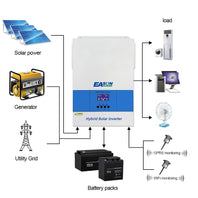Unlock the Secrets: Choosing the Perfect Solar Charge Controller for Your Energy Revolution!
Solar charge controllers are pivotal components in any solar energy system, acting as the bridge between solar panels and batteries. They regulate the voltage and current coming from the solar panels to ensure that batteries are charged efficiently without being overcharged or over-discharged. This functionality is crucial for maintaining battery health and maximizing energy storage. In this ultimate guide, we will explore the essential features to consider when selecting a solar charge controller and provide comparisons to help you make an informed decision. Whether you are a seasoned solar enthusiast or a newcomer to renewable energy, understanding these elements will empower you to harness the full potential of solar energy.

Understanding Solar Charge Controllers
A solar charge controller is an electronic device that regulates the voltage and current received from solar panels to charge batteries. It ensures that batteries are charged at the correct voltage and prevents overcharging, which can lead to battery damage and reduced lifespan. The primary benefits of using a solar charge controller include enhanced battery life, improved energy efficiency, and protection against electrical faults. Additionally, many modern controllers come equipped with advanced features like monitoring systems that provide real-time data on energy production and consumption. This functionality not only helps in maintaining the battery’s health but also gives users insight into their energy usage patterns, allowing for better energy management.
Key Features to Consider
When selecting a solar charge controller, several key features should be taken into account to ensure optimal performance:
- Type of controller: There are two main types of solar charge controllers—Pulse Width Modulation (PWM) and Maximum Power Point Tracking (MPPT). PWM controllers are simpler and less expensive but may not be as efficient as MPPT controllers, especially in larger systems.
- Voltage ratings and compatibility: Ensure that the controller is compatible with your solar panel voltage and battery system. Most systems operate at 12V, 24V, or 48V, and mismatches can lead to inefficiencies.
- Current ratings and performance metrics: The controller should be able to handle the current output of your solar panels. Look for controllers with higher current ratings to accommodate potential expansion in the future.
- Display and monitoring options: Many charge controllers feature LCD screens that provide critical information about charging status, battery health, and energy production, allowing users to monitor their systems easily.
- Protection features: A good solar charge controller should have built-in protection mechanisms against overcharging, over-discharging, and short-circuits, ensuring safety and longevity of the system.
Comparing Different Solar Charge Controllers
When comparing solar charge controllers, consider performance, efficiency, and user feedback. Start by evaluating the efficiency ratings of the controllers; MPPT controllers often deliver better performance in low-light conditions than PWM controllers. Next, read user reviews and testimonials, as they provide insights into real-world performance and reliability. It’s also useful to compare features such as monitoring capabilities and ease of installation. An anecdote from a friend who recently installed a solar system illustrates this point: he opted for an MPPT controller after researching user experiences that highlighted significant improvements in energy capture, leading to faster charging times for his batteries. By weighing these factors thoughtfully, you can find a controller that not only meets your current needs but also has the flexibility to adapt to future energy demands.
How to Choose the Right Solar Charge Controller for Your Needs
Choosing the right solar charge controller starts with assessing your personal energy needs. Consider the size and setup of your solar panel system, the capacity of your battery storage, and your typical energy consumption patterns. If you have a small setup with minimal energy needs, a basic PWM controller might suffice. However, if you’re looking to maximize efficiency and have a more extensive solar array, an MPPT controller may be the better option. Additionally, don’t forget to factor in future expansion; selecting a controller with a higher current rating can save you from having to upgrade soon after installation. Engaging with local solar communities or forums can also provide valuable insights from fellow solar users who share their experiences and recommendations based on similar energy needs.
Making an Informed Decision on Solar Charge Controllers
In summary, selecting the right solar charge controller is crucial for maximizing the efficiency of your solar energy system. By understanding the various features and comparing different options, you can make a well-informed decision that meets your energy needs and optimizes your investment in solar technology. Take your time to conduct thorough research, read reviews, and consider your future energy requirements before making a purchase. With the right solar charge controller in place, you can enjoy the benefits of renewable energy while ensuring the longevity and performance of your entire solar system.



